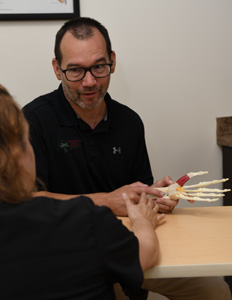DeQuervain's Tendonitis
![]() De Quervain’s Tendonitis or Tenosynovitis is a condition caused by an inflammation of the tendons located at the thumb side of the wrist. Tendons, the tissues that attach our muscles to our bones, can become swollen and sore from overuse. Traditionally, De Quervain’s Tendonitis was called “Washer Woman’s Syndrome” because of the repetitive hand movements used for wringing wet clothes. These motions of thumb pinching, squeezing, and moving the wrist outwards towards the little finger, are the motions that can cause this condition.
De Quervain’s Tendonitis or Tenosynovitis is a condition caused by an inflammation of the tendons located at the thumb side of the wrist. Tendons, the tissues that attach our muscles to our bones, can become swollen and sore from overuse. Traditionally, De Quervain’s Tendonitis was called “Washer Woman’s Syndrome” because of the repetitive hand movements used for wringing wet clothes. These motions of thumb pinching, squeezing, and moving the wrist outwards towards the little finger, are the motions that can cause this condition.
 Symptoms
Symptoms
The main symptom of De Quervain’s Tendonitis is pain on the thumb side of the wrist. Some patients also feel pain in their forearm. The pain can occur suddenly or gradually and usually becomes worse when you use your thumb and wrist to perform grasping and pinching motions. If the nerve that lies on top of the tendon sheath is irritated, it can cause the back of the thumb and index finger to feel numb.
You can also experience swelling at the wrist and thumb area. Some individuals develop a fluid-filled cyst in this region. You may hear crackling noises or feel a catch when you move your thumb, and some people have difficulty moving their thumb and wrist.
Causes
The cause of De Quervain’s Tendonitis is an irritation of the tendons at the base of the thumb. Repetitive thumb motions and moving the wrist towards the side can irritate the tendons as they move through the tendon sheath. Activities that require such motions include wringing laundry and gardening.
New mothers are especially prone to this type of tendonitis. Caring for an infant often creates awkward hand positioning, and hormonal fluctuations associated with pregnancy and nursing further contribute to its occurrence. A wrist fracture can also predispose a patient to De Quervain’s tendonitis, because of increased stresses across the tendons.
Overuse can cause the tendons to swell and accumulate fluid, resulting in a condition called Tendonitis. The lining of the tendon sheath can also become inflamed, causing a condition called Tenosynovitis. Tendonitis and Tenosynovitis can occur independently or at the same time.
Treatment Options
The goal in treating De Quervain’s tendonitis is to relieve the pain caused by irritation and swelling. Your Celebration Orthopaedics hand specialist may recommend:
-
Splints. Splints may be used to rest the thumb and wrist.
-
Anti-inflammatory medication (NSAIDs). These medications can be taken by mouth or injected into that tendon compartment. They may help reduce the swelling and relieve the pain.
-
Avoiding activities that cause pain and swelling. This may allow the symptoms to go away on their own.
-
Corticosteroids. Injection of corticosteroids into the tendon sheath may help reduce swelling and pain.
Each of these non-operative treatments helps reduce the swelling, which typically relieves pain over time. In some cases, simply stopping the aggravating activities may allow the symptoms to go away on their own.
When symptoms are severe or do not improve, surgery may be recommended. The surgery opens the compartment to make more room for the inflamed tendons, which breaks the cycle where the tight space causes more inflammation. Normal use of the hand can usually be resumed once comfort and strength have returned. Your Celebration Orthopaedics hand surgeon will advise the best treatment for your situation.
Recovery
Recovery from De Quervain’s tendonitis is very individualized, depending on the type of treatment used and the extent of surgery. Your doctor will be able to tell you what to expect. Most individuals have very good results and make a full recovery.
